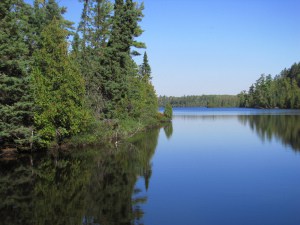
In a wide-ranging recent interview, Dr. Lee Frelich, a researcher from the University of Minnesota who studies the changing forests of the Boundary Waters ecosystem, says more evidence is appearing that the wilderness woods won’t be the same much longer.
Interviewed by Pioneer Press outdoors editor Dave Orrick, Frelich discussed his work on the impacts of global warming, invasive species, and the contentious question of new sulfide mine proposals next to the wilderness.
Warmer winters mean more maples
The Boundary Waters is perhaps best defined by its lakes and rivers, the exposed bedrock of the Canadian Shield, and the boreal forest. Frelich says as the weather warms, that northern forest is already changing. Red maple in particular is moving into the area which were previously dominated by spruce, pine, and birches.
“These trees are surviving with the warmer winters. You need minus 45 to kill a red maple, and that just doesn’t happen much anymore,” Frelich said.
Changing weather patterns are causing these forest changes in other ways, too. Wetter weather means fewer wildfires, which pine depend on for reproduction, but keep maples in check. Jackpine in particular need cold winters to thrive. Frelich has previously said that maples are also thriving in areas flattened by the 1999 blowdown. Such storms could occur more often in the centuries ahead due to warmer, wetter weather in the area.
Exotic earthworms endanger native trees
The nightcrawlers and other worms that are popular for fishing the lakes are hurting the trees. The worms like to eat the leaves and other detritus on the forest floor, which warms the soil and hurts many tree species.
Earthworms are not native to Minnesota, despite being widespread today. All the worms in the BWCAW were probably the result of being discarded by anglers.
Frelich says new research shows how worms are not only hurting native trees, but they are actually helping other invasive species. While native trees can’t survive in the type of bare soil that is the result of worms, non-native buckthorn does well in that type of growing environment. This causes changes throughout the ecosystem.
“Soybean aphids overwinter in buckthorn–which benefits from earthworms–so if you have earthworms in your soil, buckthorn is going to do very well there, which means soybean aphids will do really well there, too, and it turns out that those aphids are a favorite food for Japanese lady beetles that you see gathering on your windowsills,” Frelich said.
While live bait such as earthworms has been banned in canoe fishing destinations like Quetico Provincial Park and Sylvania Wilderness in Michigan, it is still legal in the BWCAW. Frelich suggests anglers voluntarily stop using them, or at least make sure they take everything out with them.
Mines could harm forests as well as water
In a new area of study, Frelich has produced a report which examines the potential effects of the proposed Twin Metals mine on the ecosystem. He says he researched existing studies to synthesize the findings, and found that the mines would be something like building a massive housing development in the north woods.
“The scale of the mining activity is different from suburban development. The truck traffic, for example, and windblown dust, and it’s much much more than you have when you build homes or stores. There’s an enormous amount of material that could come out of the mine. I don’t know how you can contain it all,” Frelich said.
The study was commissioned by anti-mining organization Sustainable Ely. Frelich stated that his report is based solely on scientific literature.

